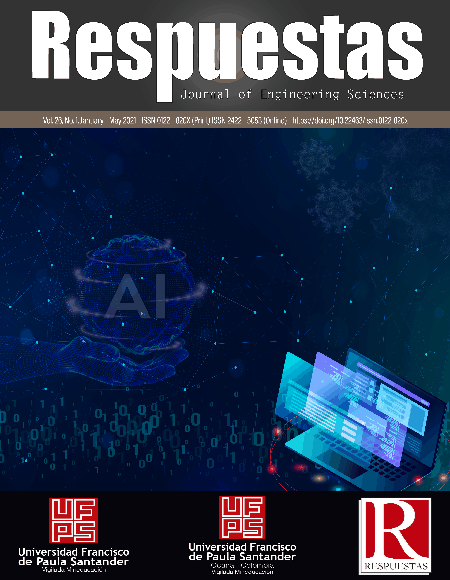Análisis y estimación gráfica del comportamiento del COVID-19 en Colombia, Santa Marta y Cartagena enfocado a la letalidad
Analysis and graphic estimation of the behavior of COVID-19 in Colombia, Santa Marta and Cartagena focused on lethality.
Contenido principal del artículo
En el presente documento se exterioriza el análisis del comportamiento de los casos diarios de contagio y de muertes por COVID - 19. Esto se lleva a cabo para evidenciar el avance de la pandemia desde sus principios y estimar el impacto de esta en un futuro cercano de forma que los entes de salud estén preparados para ejecutar planes de mitigación y contención en la población. Para lograr su realización se utilizó el método de Regresión Polinomial y Distribución Normal. Los resultados obtenidos son la curva que modela el comportamiento de los casos de contagio y de muerte desde un principio y la predicción del proceder de esta hasta finales del 2020. Las gráficas de estimación modelan el comportamiento del COVID-19 en función de su proceder ideal.
Descargas
Datos de publicación
Perfil evaluadores/as N/D
Declaraciones de autoría
Indexado en
- Sociedad académica
- Universidad Francisco de Paula Santander
- Editorial
- Universidad Francisco de Paula Santander
Detalles del artículo
M. Á. S. Valdés, “Infección respiratoria aguda por COVID-19: una amenaza evidente”, Revista Habanera de Ciencias Médicas, vol. 19, nº 1, febrero 2020.
B. NEWS, “Coronavirus: ¿Qué hizo China con respecto al brote temprano?”. 9 junio 2020. [Online]. Disponible en: https://www.bbc.com/news/world-52573137.
E. ESPECTADOR, Redacción Internacional, “América Latina: los retos en seguridad en tiempos de crisis”, 22 noviembre 2020. [Online]. Disponible en: https://www.elespectador.com/noticias/el-mundo/america-latina-los-retos-en-seguridad-en-tiempos-de-crisis/.
L. D. Acosta, “Capacidad de respuesta frente a la pandemia de COVID-19 en América Latina y el Caribe”, Revista Panamericana de Salud Pública, vol. 44, nº e109, septiembre 2020.
D. Rosselli, “Covid-19 en Colombia: los primeros 90 días”, Acta Neurológica Colombiana, vol. 36, nº 1, mayo 2020.
Statista, Abigail Orús, “Número de personas fallecidas a causa del coronavirus en el mundo a fecha de 23 de noviembre de 2020, por país”,23 noviembre 2020. [Online]. Disponible en: https://es.statista.com/estadisticas/1095779/numero-de-muertes-causadas-por-el-coronavirus-de-wuhan-por-pais/.
Centro Internacional sobre el envejecimiento, Juan Tomás Martín,” Europa se tiñe de gris”, 9 noviembre 2018. [Online]. Disponible en: https://cenie.eu/es/blog/europa-se-tine-de-gris. [Último acceso: 23 noviembre 2020].
et al., “Preparación y control de la enfermedad por coronavirus 2019 (COVID-19) en América Latina”, Acta Médica Peruana, vol. 37, nº 1, marzo 2020.
et al., «Encajando el puzle: Una estimación rápida del número de infectados por COVID-19 en España a partir de fuentes indirectas,» Documentos de trabajo (FEDEA), nº 5, 2020.
arXiv, H. C., D. I., Y. W.Y., “Contact Tracing Mobile Apps for COVID-19: Privacy Considerations and Related Trade-offs”, 30 Marzo 2020. [Online]. Disponible en: https://arxiv.org/abs/2003.11511.
E. NOTICIA, “Investigadores desarrollan una app que predice la evolución del coronavirus los próximos tres días”, 04 abril 2020. [Online]. Disponible en: https://www.20minutos.es/noticia/4216598/0/investigadores-desarrollan-app-predice-. evolucion-coronavirus-proximos-tres-dias/?autoref=true.
D. M. López, “Uso de tecnologías en el lugar de atención para el manejo de la pandemia por COVID-19 en Colombia”, Revista Panamericana de Salud Pública, vol. 44, nº e97, agosto 2020.
Instituto Nacional de Salud, et al., “Modelo de Transmisión del Coronavirus COVID-19”, 22 abril 2020. [Online]. Disponible en: https://www.ins.gov.co/Direcciones/ONS/SiteAssets/Modelo%20COVID-19%20Colombia%20INS_v5.pdf.
W. C. M. S. M. Gabriel Chanchí Golondrino, «Aplicación de la regresión polinomial para la caracterización de la curva del COVID-19, mediante técnicas de machine learning,» Investigación e Innovación en Ingenierías, vol. 8, nº 2, 2020.
MATLAB Central File Exchange, C. Tapia, “APP de COVID 19 con MATLAB”, febrero 2020. [Online]. Disponible en: https://la.mathworks.com/matlabcentral/fileexchange/75152-app-de-covid-19-con-matlab.
OpenStreetMap Contributors, et al., “The Coronavirus App”, Open Database License, 2020. [Online]. Disponible en: https://coronavirus.app/map.
Instituto Nacional de Salud, «INS», 2020. [Online]. Disponible en: https://www.ins.gov.co/Noticias/Paginas/coronavirus-casos.aspx.
Organización Panamericana de la salud, “COVID-19 Y LA IMPORTANCIA DE FORTALECER LOS SISTEMAS DE INFORMACIÓN”, 2020. [Online]. Disponible en: https://iris.paho.org/bitstream/handle/10665.2/52128/COVID-19FactsheetIS4H_spa.pdf?sequence=14&isAllowed=y.
ABC Sociedad, L.A., “El coronavirus, comparado con las pandemias más letales de la historia”, 14 abril 2020. [Online]. Disponible en: https://www.abc.es/sociedad/abci-coronavirus-no-lejos-peor-epidemias-mas-letales-historia-202003201350_noticia.html.
et al., “COVID-19 in Colombia endpoints. Are we different, like Europe?”, Research in Social and Administrative Pharmacy, vol. 17, nº 1, enero 2021.
M. A. V. K. H. Antonio J Bravo, «Modelos matemáticos estimadores de la infección por COVID-19: Consideraciones esenciales y proyecciones en Colombia,» Revistas de Salud Pública, vol. 22, nº 3, mayo 2020.
Universitat de Barcelona, “TÉCNICAS DE PREDICCIÓN”, 2020. [Online]. Disponible en: http://www.ub.edu/aplica_infor/spss/cap8-5.htm.
G. M. Reyes, “La función de probabilidad normal: Características y aplicaciones”, eXtoikos, nº 6, 2012.
Ministerio de Salud y Protección Social Colombiano, “Datos Abiertos”,2020. [Online]. Disponible en: https://www.datos.gov.co/Salud-y-Protecci-n-Social/Casos-positivos-de-COVID-19-en-Colombia/gt2j-8ykr/data.
J. D. S, “LA DISTRIBUCIÓN NORMAL”, Revista Chilena de Anestesia, vol. 43, nº 2, 2014.
J. A. Rodrigo, “Métodos de regresión no lineal: regresión polinómica, regression splines, smooth splines y GAMs”, febrero 2017 [Online]. Disponible en: https://www.cienciadedatos.net/documentos/32_metodos_de_regresion_no_lineal_polinomica_splines_gams.
H. J. M. L. A. Ransnas, “Fitting curves to data using nonlinear regression: a practical and nonmathematical review”, The FASEB Journal, vol. 1, nº 5, 1987.
I. © The MathWorks, “polyfit”, MathWorks, 2005. [Online]. Disponible en: https://la.mathworks.com/help/matlab/ref/polyfit.html.
R. Ferrer, “Pandemia por COVID-19: el mayor reto de la historia del intensivismo”, ScienceDirect, vol. 44, nº 6, pp. 323-324, 2020.
L. S.-C. N. T. María Cecilia Johnson, “Emociones, preocupaciones y reflexiones frente a la pandemia del COVID-19 en Argentina”, SciELO, vol. 25, p. 2447-2456, 2020.









